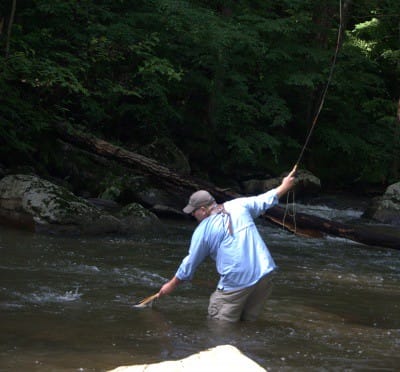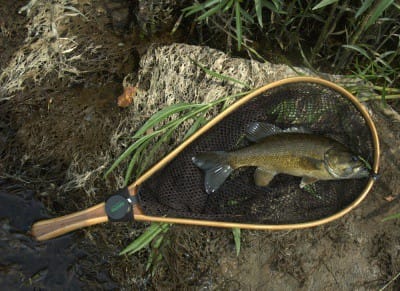
This past week I had a chance to get away and do some much needed fishing. In the heat of summer, I often go after smallmouth bass since trout fishing in July and August can be tough. Not only are trout less likely to bite, when they do the stress and strain of fighting it out with an angler often pushes the fish over their survival limit. Warm water generally holds less oxygen and trout can’t easily survive with the lower water conditions, again because of the heat, and predation comes into play as well when herons and other birds of prey feast on unsuspecting trout. Wet wading has several advantages. First is the speed factor: Unencumbered with waders, all you need to fish is your shoes and vest (and shorts, please). Another advantage is that you can feel the change of water temperature against your skin when you wet wade. By contrast, waders insulate you from the water’s temperature variations. Fish often seek out cooler pockets in the river during the dog days of summer, so being able to feel the water’s temperature against your skin is a plus. Leaving my waders behind also allows me to wade into water much deeper than I normally would. If I am confident of a river’s bottom, I will wade into water almost to my armpits—something I would never be able to do wearing waders. Finally, waders are the last thing you want to be wearing on a hot, sticky summer day. Even breathable waders can cause you to overheat in the summer.
Another great upside to wet wading is you really don’t need much gear when fishing for smallies in particular. I carry my normal supply of flies, which means I could loose 2 dozen and still be OK. In reality however, you usually only need two or three flies to be successful when wet wading. I like using surface flies in the summer like Hickey’s Condor, a damsel fly imitation and Walt’s Poppers. Both are long lasting and really make the smallies come to the top. When surface flies don’t get the response I’m looking for I turn to streamers which can even pass for crayfish, or the simple wooly bugger with a bead head. Both of these flies really move fish and I’ve found if these patterns don’t solicit a strike after carefully fishing an area, it’s time to move to a new river or call it a day.
Are there downsides to leaving those waders at home? Sure. For one, your skin is directly exposed to all of the “no-see-‘ems” in the water. (This troubles my wife much more than it does me.) For another, “discovering” hidden rocks and underwater tree limbs with your shins may be less pleasant sans waders. Combine these two points-wading unprotected in potentially polluted water with an open wound or two-and you could land yourself a serious infection.
Convenience is also a factor in the wader decision. Most waders have pockets or some type of interior shelf built into them that allows you to bring extra gear along like fly boxes or perhaps even a water bottle. Not so with shorts.
Wet Wading Pointers
Wet wading is not for everyone. If you don’t feel completely comfortable with it, start out in shallow or very familiar water. Also concentrate on rivers with less current or in large flat pools so if you do fall, there is much less chance of you getting hurt.
Wear felt-soled shoes in the river if this is permitted in your state. Wading sandals are available for the minimalists among us, but be aware that these sandals may not give you the same ankle support that your regular wading shoes do. Another problem with wading sandals is they often lack the toe support or coverage that other wading shoes provide. This is not always the case and it’s best to look around at some of the larger wader manufacturers and see if they have sandals, or other low profile wading shoes that you can wear. Also, don’t forget sunscreen on your legs-a common angler’s mistake because the legs are normally covered by waders. You can also carry a wading staff for added safety.

Be sure to carry a frozen container of Gatorade or similar non-carbonated beverage to drink throughout the day. Most fly vests come with a big pocket in the back that allows for a water bottle which I often fill completely with ice. After an hour or two of fishing, that water tastes might good.
Last but not least take along a towel to sit on for the ride home. Otherwise, your car may smell like river for quite some time after your trip-as I discovered the hard way.
Beau Beasley (www.beaubeasley.com) is an author and career captain with Fairfax County Fire and Rescue and a member of Local 2068. For more information about Beau or his books check out his web-site or e-mail him at fishutopia@comcast.net



